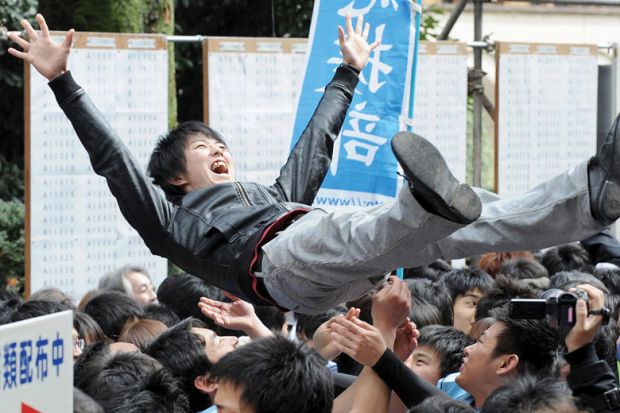The growth in higher education across the world has been one of the most remarkable social transformations of the past 40 years. Back in 1971, the GDP per capita of South Korea was less than a dollar a day (about an eighteenth of that enjoyed by US citizens) and just 7 per cent of young people entered any kind of tertiary education.
Fast-forward to 2015, and almost every young person in the country enrols in tertiary education (which includes both three-year university degrees and shorter two-year courses like those offered by US community colleges).
South Korea has been described as having a “mania” for education; last year, a documentary called Reach for the Sky followed youngsters stressed to breaking point in the struggle to win a place at one of the country’s elite universities. Planes are grounded and the stock market opens late to avoid disturbing students sitting university entrance exams.
In almost every region of the world (see chart, below), there has been a boom in tertiary education since the early 1970s.
Academics may be proud to be part of this massive expansion in access to learning. But according to new research by an expert on international higher education, the advent of “high-participation systems” may actually reinforce existing inequalities, making it harder for youngsters to climb the ladder of social mobility.
“In a system with 15 per cent participation, there is less competitive pressure and less stratified outcomes than a system with 50 per cent participation,” explains Simon Marginson, professor of international higher education at University College London.
In an environment where just 15 per cent enter higher education – Britain in the 1970s, for example – “it is possible to have a successful middle-class life without going to university”, he says. Those who do go to university get a real benefit regardless of where they attend, he says.
But in today’s world, where about half of youngsters go to university, “the whole middle class is in the system and pursuing the success of its children”, he says. There is far more intense competition for places at “elite” universities, because “participation in non-elite [universities] no longer generates guaranteed professional jobs”.
The global rise in university study: gross tertiary enrolment ratio (%), world and world regions, 1971 to 2013
Source: Charts prepared by Simon Marginson using Unesco data.
*Data for 1971-79 not available
“In any competition, those with the best starting resources are most likely to win,” Marginson told Times Higher Education.
The result is that across the world, more higher education has at best failed to shake up social inequalities, and at worst increased middle-class dominance of the best opportunities, Marginson has concluded in a study amassing data from dozens of countries.
“The worldwide trend to high participation high education: dynamics of social stratification in inclusive systems”, published in the latest issue of Higher Education, is littered with surprising and disturbing conclusions.
The private institutions of the US Ivy League are “engines of social advantage”, it says; Marginson quotes a study that found that between 1988 and 2000, about two-thirds of entrants were from the top 10 per cent of families in terms of income.
Another cited study found that excellent school students sorted themselves into different types of university depending on family background. Those from low-income families “opted for uniformly safe choices” and applied to less selective colleges.
The more stratified a system is between “elite” institutions and the rest, the more likely it is to perpetuate inequality, Marginson says. The Netherlands and Nordic countries have created a more equal system, he points out, but much of the rest of the world “seems to be revelling in the celebrity status of a small number of leading universities in ‘winner-take-all’ markets, without regard to the effects for the rest of the institutions and their users”, he says. “We have a kind of ‘Harvard-itis’.”
Echoing critics such as University of Cambridge economist Ha-Joon Chang, Marginson also argues that the rise of higher education has not been driven primarily by greater demand for education from employers and the economy.
Instead, the huge growth in university attendance has been “powered by the ambitions of families for social position and of students for self-realisation”, his paper argues.
Higher education becomes “entrenched as the route to a middle class life”, and as a result families begin to see it as essential to maintain their social status, he writes.
POSTSCRIPT:
Print headline: With greater participation, even ‘greater inequality’
Register to continue
Why register?
- Registration is free and only takes a moment
- Once registered, you can read 3 articles a month
- Sign up for our newsletter
Subscribe
Or subscribe for unlimited access to:
- Unlimited access to news, views, insights & reviews
- Digital editions
- Digital access to THE’s university and college rankings analysis
Already registered or a current subscriber? Login








